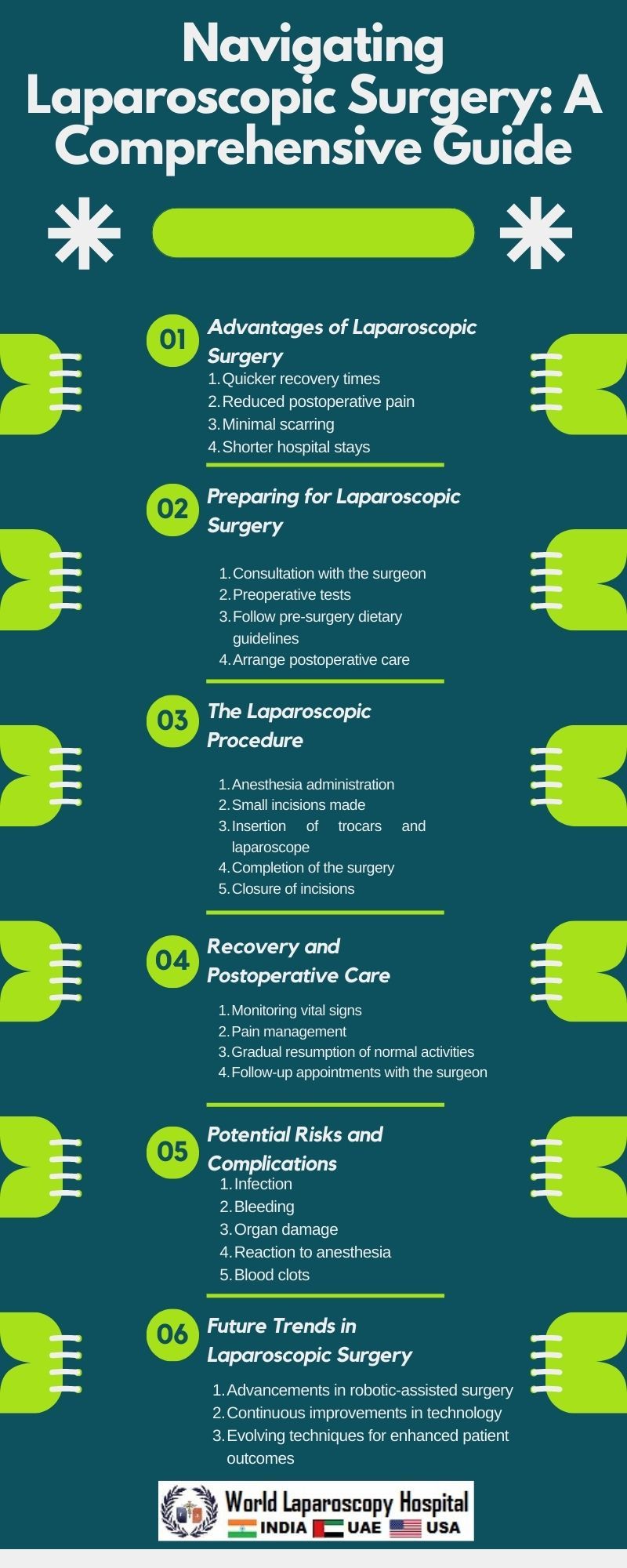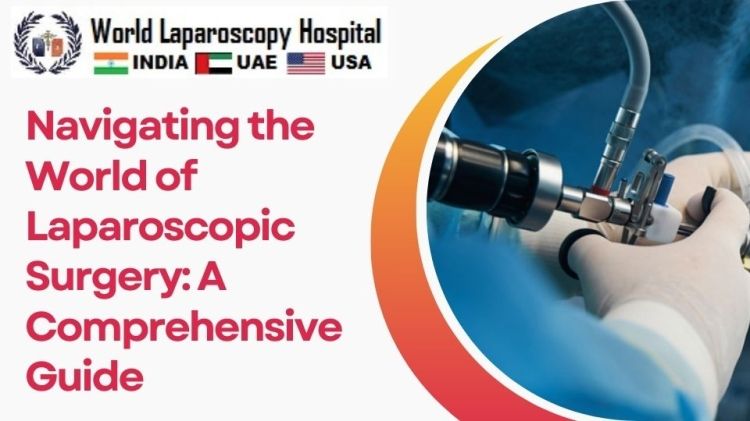Navigating the World of Laparoscopic Surgery: A Comprehensive Guide
Navigating the World of Laparoscopic Surgery: A Comprehensive Guide
Introduction:
Laparoscopic surgery, also known as minimally invasive surgery, has revolutionized the field of medicine, offering patients and healthcare professionals a less invasive alternative to traditional open surgeries. This comprehensive guide aims to provide an in-depth exploration of laparoscopic surgery, covering its history, techniques, instruments, applications, benefits, and future developments.

History of Laparoscopic Surgery:
The roots of laparoscopic surgery can be traced back to the early 20th century, with the first successful laparoscopic procedure performed in 1902 by Georg Kelling. However, it wasn't until the latter half of the century that technological advancements allowed for widespread adoption. The introduction of fiber optics and video technology in the 1970s played a pivotal role in enhancing visualization during these procedures.
Fundamental Techniques:
Laparoscopic surgery involves making small incisions through which a camera and specialized instruments are inserted. Surgeons operate while watching a high-definition video feed of the internal organs, providing a detailed and magnified view. Key techniques include insufflation (the introduction of gas to create a working space), trocar placement, and precise manipulation using long, slender instruments.
Instrumentation in Laparoscopic Surgery:
The success of laparoscopic surgery heavily relies on specialized instruments designed for minimal invasiveness and precision. Trocars, graspers, scissors, and staplers are among the essential tools used. Advancements in robotics have also introduced robotic-assisted laparoscopic surgery, offering enhanced dexterity and improved ergonomics for surgeons.
Applications Across Medical Specialties:
Laparoscopic surgery has transcended various medical disciplines. In gynecology, it's commonly used for hysterectomies and ovarian procedures. In gastroenterology, procedures like cholecystectomy (gallbladder removal) and appendectomy are frequently performed laparoscopically. Additionally, the approach is employed in urology, orthopedics, and even certain cardiac surgeries.
Benefits of Laparoscopic Surgery:
Minimal Scarring:
The small incisions result in significantly less scarring compared to traditional open surgeries, contributing to improved cosmetic outcomes and reduced postoperative pain.
Faster Recovery:
Patients typically experience shorter hospital stays and quicker recovery times due to reduced trauma to surrounding tissues.
Reduced Blood Loss:
The minimally invasive nature of laparoscopic surgery often leads to less blood loss during procedures, minimizing the need for blood transfusions.
Lower Infection Rates:
Smaller incisions decrease the risk of infections, a crucial factor in postoperative recovery.
Improved Visualization:
Surgeons benefit from enhanced visualization, allowing for precise and meticulous surgical maneuvers.
Challenges and Considerations:
While laparoscopic surgery offers numerous advantages, it is not without challenges. Surgeons must contend with a learning curve associated with mastering the techniques and instruments. Additionally, certain complex procedures may still necessitate open surgery due to technical limitations or patient-specific factors.
Recent Advancements and Future Prospects:
The field of laparoscopic surgery continues to evolve with ongoing technological advancements. Virtual reality (VR) and augmented reality (AR) are being explored to enhance surgical training and improve preoperative planning. Furthermore, the integration of artificial intelligence (AI) holds promise for optimizing decision-making during procedures and improving overall surgical outcomes.
Patient Perspective and Experiences:
Real-world experiences of patients who have undergone laparoscopic surgery provide valuable insights. Interviews and case studies can shed light on the emotional and physical impact of this approach, offering a holistic understanding beyond the medical and technical aspects.
Conclusion:
As we celebrate the one-year anniversary of this comprehensive guide to laparoscopic surgery, it is evident that this innovative approach has transformed the landscape of modern medicine. From its historical roots to current applications and future potentials, the guide aims to serve as a timeless resource for healthcare professionals, students, and anyone intrigued by the fascinating world of minimally invasive surgery. As technology continues to advance, so too will the possibilities and refinements within the realm of laparoscopic surgery.
Top
Introduction:
Laparoscopic surgery, also known as minimally invasive surgery, has revolutionized the field of medicine, offering patients and healthcare professionals a less invasive alternative to traditional open surgeries. This comprehensive guide aims to provide an in-depth exploration of laparoscopic surgery, covering its history, techniques, instruments, applications, benefits, and future developments.

History of Laparoscopic Surgery:
The roots of laparoscopic surgery can be traced back to the early 20th century, with the first successful laparoscopic procedure performed in 1902 by Georg Kelling. However, it wasn't until the latter half of the century that technological advancements allowed for widespread adoption. The introduction of fiber optics and video technology in the 1970s played a pivotal role in enhancing visualization during these procedures.
Fundamental Techniques:
Laparoscopic surgery involves making small incisions through which a camera and specialized instruments are inserted. Surgeons operate while watching a high-definition video feed of the internal organs, providing a detailed and magnified view. Key techniques include insufflation (the introduction of gas to create a working space), trocar placement, and precise manipulation using long, slender instruments.
Instrumentation in Laparoscopic Surgery:
The success of laparoscopic surgery heavily relies on specialized instruments designed for minimal invasiveness and precision. Trocars, graspers, scissors, and staplers are among the essential tools used. Advancements in robotics have also introduced robotic-assisted laparoscopic surgery, offering enhanced dexterity and improved ergonomics for surgeons.
Applications Across Medical Specialties:
Laparoscopic surgery has transcended various medical disciplines. In gynecology, it's commonly used for hysterectomies and ovarian procedures. In gastroenterology, procedures like cholecystectomy (gallbladder removal) and appendectomy are frequently performed laparoscopically. Additionally, the approach is employed in urology, orthopedics, and even certain cardiac surgeries.
Benefits of Laparoscopic Surgery:
Minimal Scarring:
The small incisions result in significantly less scarring compared to traditional open surgeries, contributing to improved cosmetic outcomes and reduced postoperative pain.
Faster Recovery:
Patients typically experience shorter hospital stays and quicker recovery times due to reduced trauma to surrounding tissues.
Reduced Blood Loss:
The minimally invasive nature of laparoscopic surgery often leads to less blood loss during procedures, minimizing the need for blood transfusions.
Lower Infection Rates:
Smaller incisions decrease the risk of infections, a crucial factor in postoperative recovery.
Improved Visualization:
Surgeons benefit from enhanced visualization, allowing for precise and meticulous surgical maneuvers.
Challenges and Considerations:
While laparoscopic surgery offers numerous advantages, it is not without challenges. Surgeons must contend with a learning curve associated with mastering the techniques and instruments. Additionally, certain complex procedures may still necessitate open surgery due to technical limitations or patient-specific factors.
Recent Advancements and Future Prospects:
The field of laparoscopic surgery continues to evolve with ongoing technological advancements. Virtual reality (VR) and augmented reality (AR) are being explored to enhance surgical training and improve preoperative planning. Furthermore, the integration of artificial intelligence (AI) holds promise for optimizing decision-making during procedures and improving overall surgical outcomes.
Patient Perspective and Experiences:
Real-world experiences of patients who have undergone laparoscopic surgery provide valuable insights. Interviews and case studies can shed light on the emotional and physical impact of this approach, offering a holistic understanding beyond the medical and technical aspects.
Conclusion:
As we celebrate the one-year anniversary of this comprehensive guide to laparoscopic surgery, it is evident that this innovative approach has transformed the landscape of modern medicine. From its historical roots to current applications and future potentials, the guide aims to serve as a timeless resource for healthcare professionals, students, and anyone intrigued by the fascinating world of minimally invasive surgery. As technology continues to advance, so too will the possibilities and refinements within the realm of laparoscopic surgery.






